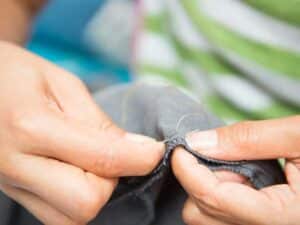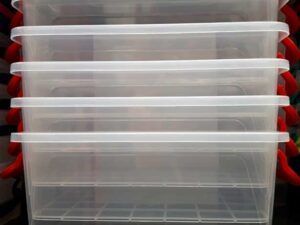Believe it or not, there are countries in the world where citizens can wear the same clothes all year round if they choose. Here in the UK, where we can experience all four seasons in a single day, it can be more difficult to maintain a ‘capsule wardrobe’ and we can find ourselves seriously short of household storage space.
On the whole, most of us could divide our wardrobes into spring/summer and autumn/winter collections. The items we wear in spring and summer may at times be ridiculously optimistic, but we persist in sporting shorts, dresses and t-shirts even in the most fickle climate. Those items can crease with frustrating ease and become lost and forgotten about when buried beneath clothing we would normally wear in the traditionally colder months.
Conversely, our autumn/winter clothes may become spoiled, misshapen and even mouldy if left to fester in the back of our wardrobes whilst we persist in wearing thinner clothes designed for the more temperate months.
The answer to the issue of an overcrowded and ill-used wardrobe is, of course, to store our spring/summer clothes apart from our autumn/winter clothes. Storing clothes properly takes a little preparation, but having a wardrobe or chest of drawers that is not fit to burst (and in which you can find just the item you are looking for on any given day) is well worth the effort. Here are a few tips on how to store clothes that you are not likely to wear for a season or two:
Wash and dry them properly
 Before you put your clothes into storage, you really should clean your clothes properly. That may mean simply running them through the washing machine, or it may mean a trip to the dry cleaners depending on the item of clothing to be stored. Do not bother to iron your clothes as you will have to iron them again once you retrieve them from storage, and who has time to iron clothes twice? If you need persuading that an item needs cleaning before you store it, remember that deodorant and perfume can stain over time, and creepy crawlies love dust and dirt.
Before you put your clothes into storage, you really should clean your clothes properly. That may mean simply running them through the washing machine, or it may mean a trip to the dry cleaners depending on the item of clothing to be stored. Do not bother to iron your clothes as you will have to iron them again once you retrieve them from storage, and who has time to iron clothes twice? If you need persuading that an item needs cleaning before you store it, remember that deodorant and perfume can stain over time, and creepy crawlies love dust and dirt.
Polish boots and shoes
 Shoes and boots should be cleaned and polished (rub a little oil into leather items, but be sure to keep these separate from your other clothes) and stuffed with clean tissue paper to help them to keep their shape before putting them into storage. See our post 'How to Store Boots Safely' for professional tips on storing boots.
Shoes and boots should be cleaned and polished (rub a little oil into leather items, but be sure to keep these separate from your other clothes) and stuffed with clean tissue paper to help them to keep their shape before putting them into storage. See our post 'How to Store Boots Safely' for professional tips on storing boots.
Get rid of clothes that you won't wear again
 If you haven’t worn something for a year, you probably won’t wear it again. You may have to resign yourself to the idea that you won’t drop three dress sizes by this time next year, or that you and tartan really don’t go well together, or that the dog really did do quite a lot of damage to that jumper you love so much. Be ruthless when storing clothes and sort your items into three piles: keep (store), give to charity (or friends) and bin.
If you haven’t worn something for a year, you probably won’t wear it again. You may have to resign yourself to the idea that you won’t drop three dress sizes by this time next year, or that you and tartan really don’t go well together, or that the dog really did do quite a lot of damage to that jumper you love so much. Be ruthless when storing clothes and sort your items into three piles: keep (store), give to charity (or friends) and bin.
Repair any damaged items
 Anything that you intend to keep should be checked for damage and repaired before you store them. Your future self will thank you (when retrieving your items) for sewing on missing buttons and stitching up small holes now.
Anything that you intend to keep should be checked for damage and repaired before you store them. Your future self will thank you (when retrieving your items) for sewing on missing buttons and stitching up small holes now.
Don't use vac storage bags for long term clothes storage
 Vac storage bags are a great invention and can save you a huge amount of space. There is also something very satisfying about watching a huge bag filled with all your bulky winter jumpers being steadily shrunk until it is almost miraculously thin.
Vac storage bags are a great invention and can save you a huge amount of space. There is also something very satisfying about watching a huge bag filled with all your bulky winter jumpers being steadily shrunk until it is almost miraculously thin.
However, keeping items made from natural fibres such as wool and silk in a plastic bag can damage them and make them lose shape over time. Vacuum bags may, therefore, be fine for a few weeks, but if you plan to leave your items in their storage for a few months, opt for plastic storage boxes instead. Choose boxes that have an airtight lid so that your clothes will remain dry and free from mould and mildew.
Don't bother ironing first and pack properly
 You may not have to iron them, but you should still pack your clothes with care. Heavier items should be placed at the bottom of the bag or box and lighter, more delicate items at the top. You may find that you are able to fit more clothes into the same space if you roll them rather than fold them – this is an odd quirk of physics but it seems to be true. Don’t over-stuff your container as your items may lose their shape and will be a real pain to iron once you have retrieved them. If you have items that should be hung rather than rolled/folded, consider investing in a storage box that has a hanging rail.
You may not have to iron them, but you should still pack your clothes with care. Heavier items should be placed at the bottom of the bag or box and lighter, more delicate items at the top. You may find that you are able to fit more clothes into the same space if you roll them rather than fold them – this is an odd quirk of physics but it seems to be true. Don’t over-stuff your container as your items may lose their shape and will be a real pain to iron once you have retrieved them. If you have items that should be hung rather than rolled/folded, consider investing in a storage box that has a hanging rail.
Store them in the right location
When storing clothes, the rule of thumb is that the temperature of your chosen storage location should be no warmer than 23C, with a relative humidity of 55C. However, as long as you find somewhere to keep your clothes that is dry, cool, clean and dark (since bright light fades colours), they should look as fresh coming out of storage as they did going in. If space is an issue in your house, or if you are just too scared to go into your loft, consider putting your storage boxes into the care of a storage company for a few weeks or months.
You can store accessories as well
Once you have stored your autumn/winter clothes, you can more easily access your spring/summer clothes. When the months start to turn cold again (or colder, anyway) you can retrieve your autumn/winter clothes from storage and swap them with your spring/summer clothes, following the advice set out above again. Hopefully you know know how to store clothes properly.

